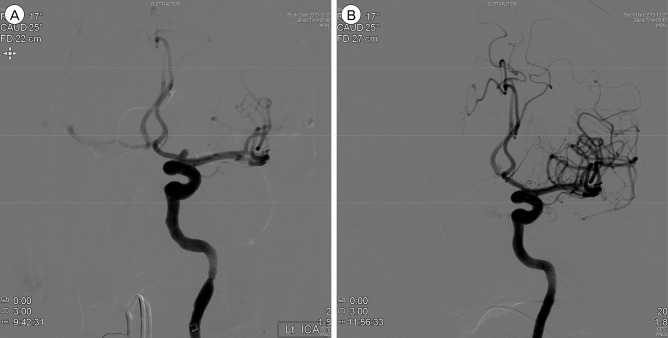J Cerebrovasc Endovasc Neurosurg.
2016 Sep;18(3):234-238. 10.7461/jcen.2016.18.3.234.
The Benefits of Navienâ„¢ Intracranial Support Catheter for Endovascular Treatment
- Affiliations
-
- 1Department of Neurosurgery, Presbyterian Medical Center, Jeonju, Korea. lsw1430@gamil.com
- KMID: 2355647
- DOI: http://doi.org/10.7461/jcen.2016.18.3.234
Abstract
OBJECTIVE
Endovascular treatment is one of the most important treatments along with open craniotomy for cerebrovascular surgery. The successful treatment of endovascular disease relies on appropriate instruments and the surgeon's skill. Endovascular treatment needs to provide safe and stable access to the catheter cavity. Additionally, it is important to maintain a round shape without changing to an oval shape. The catheter for endovascular treatment has to be flexible and accommodate at least 0.027 inches of inner diameter. The 6-Fr Navienâ„¢ Intracranial Support Catheter (formerly the ReFlex Intracranial Catheter; Covidien Vascular Therapies, Mansfield, MA, USA) provides 0.072 inches of inner diameter.
MATERIALS AND METHODS
We reviewed 61 cases for 56 cases of endovascular treatment with a Navien catheter. A triaxial system was used for all procedures with femoral arterial access. The Navien catheter was placed in the petrous segment of the internal carotid artery or third segment of the vertebral artery. The patients had various shapes of intracranial arteries, including tortuous vessels.
RESULTS
The Navien catheter was used for 61 cases of endovascular treatment. We had 59 cases of coil embolization at unruptured and ruptured aneurysms and two cases of stent insertion into the middle cerebral artery. All the cases were successful without any catheter-related complications.
CONCLUSION
The Navien catheter is a recently developed catheter that has several strengths compared with previously developed catheters. It provides a more stable environment for endovascular treatment. It provides a cavity sufficient for endovascular treatment devices. Additionally, it is sufficiently flexible to approach tortuous vessels.
MeSH Terms
Figure
Cited by 1 articles
-
Use of Distal Intracranial Catheters for Better Working View of Cerebral Aneurysms Hidden by Parent Artery or Its Branches: A Technical Note
Ehab Mahmoud, Samuel Lenell, Christoffer Nyberg, Ljubisa Borota
Neurointervention. 2021;16(3):267-274. doi: 10.5469/neuroint.2021.00269.
Reference
-
1. Blanc R, Piotin M, Mounayer C, Spelle L, Moret J. Direct cervical arterial access for intracranial endovascular treatment. Neuroradiology. 2006; 12. 48(12):925–929. PMID: 17102976.
Article2. Cai Y, Spelle L, Wang H, Piotin M, Mounayer C, Vanzin JR, et al. Endovascular treatment of intracranial aneurysm in the elderly: Single-center experience in 63 consecutive patients. Neurosurgery. 2005; 12. 57(6):1096–1102. discussion 1096-102. PMID: 16331156.3. Fraser JF, Riina H, Mitra N, Gobin YP, Simon AS, Stieg PE. Treatment of ruptured intracranial aneurysms: looking to the past to register the future. Neurosurgery. 2006; 12. 59(6):1157–1166. Discussion 1166-7. PMID: 17277678.4. Colby GP, Lin LM, Huang J, Tamargo RJ, Coon AL. Utilization of the Navien distal intracranial catheter in 78 cases of anterior circulation aneurysm treatment with the Pipeline embolization device. J Neurointerv Surg. 2013; 11. 5(Suppl 3):iii16–iii21. PMID: 23516269.
Article5. Hu YC, Stiefel MF. Force and aspiration analysis of the ADAPT technique in acute ischemic stroke treatment. J Neurointerv Surg. 2016; 3. 8(3):244–246. PMID: 25618896.
Article6. Ishihara H, Ishihara S, Niimi J, Neki H, Kakehi Y, Uemiya N, et al. Risk factors and prevention of guiding catheter-induced vasospasm in neuroendovascular treatment. Neurol Med Chir (Tokyo). 2015; 55(3):261–265. PMID: 25739431.
Article7. Dinh J, Castenada M, Shimada LM, Torres SE, Strauss BM, Valko JJ, et al. Distal access balloon guide catheter (2015) US Patent No. 8,926,560. Washington, DC: US Patint and Trademark Office.8. Lin LM, Colby GP, Huang J, Tamargo RJ, Coon AL. Ultra-distal large-bore intracranial access using the hyperflexible Navien distal intracranial catheter for the treatment of cerebrovascular pathologies: a technical note. J Neurointerv Surg. 2014; 5. 6(4):301–307. PMID: 23729497.
Article9. Peterson EC, Heros RC. Editorial: More on the clip versus coil controversy. J Neurosurg. 2015; 9. 123(3):618–620. PMID: 26047419.
Article10. Sorenson T, Lanzino G. Trials and tribulations: An evidence-based approach to aneurysm treatment. J Neurosurg Sci. 2016; 3. 60(1):22–26. PMID: 27102908.
- Full Text Links
- Actions
-
Cited
- CITED
-
- Close
- Share
- Similar articles
-
- Endovascular treatment of intracranial aneurysms: Past and present
- Current Update on the Randomized Controlled Trials of Intracranial Aneurysms
- Endovascular Management of Intracranial Aneurysms: Advances in Stenting Techniques and Technology
- Endovascular Treatment of Intracranial AVM
- Complications after Endovascular Treatment




